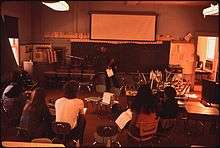Havasupai–Hualapai language
| Havasupai–Hualapai | |
|---|---|
| Upland Yuman | |
| Region | Arizona, United States |
| Ethnicity | 565 Havasupai, 1,870 Walapai (2007)[1] |
Native speakers | 1,500 (2007)[1] |
|
Yuman–Cochimí
| |
| Dialects |
|
| Language codes | |
| ISO 639-3 |
yuf (includes Yavapai) |
| Glottolog |
hava1248[2] |
Havasupai–Hualapai (Havasupai–Walapai) is the Native American language spoken by the Hualapai (Walapai) and Havasupai peoples of northwestern Arizona. It is closely related to the Yavapai language.
Havasupai–Hualapai belongs to the Pai branch of the Yuman–Cochimí language family, together with Yavapai and Paipai, which is spoken in northern Baja California. The two groups have separate sociopolitical identities, but a consensus among linguists is that the differences in speech among them lie only at the dialect level, rather than constituting separate languages (Campbell 1997:127; Goddard 1996:7; Kendall 1983:5-7; Mithun 1999:577-578). The Havasupai and Hualapai report that they speak the same language, and indeed the differences between their dialects have been reported as "negligible" (Kozlowski 1976:140).
For a bibliography of texts, grammars, and dictionaries that document the language, see Langdon 1996.
Havasupai dialect

This dialect is spoken by fewer than 450 people on the Havasupai Indian Reservation at the bottom of the Grand Canyon. It is the only Native American language in the United States of America spoken by 100% of its indigenous population. As of 2005, Havasupai remained the first language of residents of Supai Village, the tribal government seat.[3]
As of 2004, "a Wycliffe Bible Translators project ... under way to translate the Old and the New Testaments into the Havasupai language" was progressing slowly.[4]
See also
- Havasu 'Baaja, the people generally called Havasupai by English-speakers.
Bibliography
- Campbell, Lyle. (1997). American Indian Languages: The Historical Linguistics of Native America. Oxford University Press.
- Goddard, Ives. (1996). "Introduction". In Languages, edited by Ives Goddard, pp. 1–16. Handbook of North American Indians, William C. Sturtevant, general editor, Vol. 17. Smithsonian Institution, Washington, D.C.
- Kendall, Martha B. (1983). "Yuman languages". In Southwest, edited by Alfonso Ortiz, pp. 4–12. Handbook of North American Indians, William C. Sturtevant, general editor, Vol. 10. Smithsonian Institution, Washington, D.C.
- Langdon, Margaret. (1996). "Bibliography of the Yuman languages". Survey of California and Other Indian Languages 9:135-159.
- Mithun, Marianne. (1999). The Languages of Native North America. Cambridge: Cambridge University Press.
- Kozlowski, Edwin. (1976). "Remarks on Havasupai phonology". In International Journal of American Linguistics, pp. 140–149. Vol. 42, No. 2.
- Watahomigie, Lucille J., Jorigine Bender, Philbert Watahomigie, Sr. and Akira Y. Yamamoto with Elnor Mapatis, Malinda Powskey and Josie Steele. (2001). Hualapai Reference Grammar. (ELPR Publications A2-003). Kyoto, Japan: Endangered Languages of the Pacific Rim Project.
- Watahomigie, Lucille J., Jorigine Bender, Malinda Powskey, Josie Steele, Philbert Watahomigie, Sr. and Akira Y. Yamamoto. (2003). A Dictionary of the Hualapai Language. (ELPR Publications A2-041). Kyoto, Japan: Endangered Languages of the Pacific Rim Project.
References
- 1 2 Havasupai–Hualapai at Ethnologue (18th ed., 2015)
- ↑ Hammarström, Harald; Forkel, Robert; Haspelmath, Martin; Bank, Sebastian, eds. (2016). "Havasupai-Walapai-Yavapai". Glottolog 2.7. Jena: Max Planck Institute for the Science of Human History.
- ↑ "Indigenous Voices of the Colorado Plateau - Havasupai Overview". Cline Library. 2005. Retrieved 2012-12-02.
- ↑ Lynn Arave (2004-04-17). "The farthest church". Deseret News. Retrieved 2012-12-02.
Further reading
- "A dictionary of the Havasupai language". Hinton, Leanne. Supai, Arizona 1984.
- "Gwe gnaavja". Havasu Baaja / Havasupai Tribe, Bilingual Education Program. Supai, Arizona 1985.
- "Havsuw gwaawj tñudg siitja". Havasupai Bilingual Education Program. Supai, Arizona 1970s(?).
- "Baahj muhm hatm hwag gyu". Hinton, Leanne et al., prepared by the Havasupai Bilingual Education Program. Supai, Arizona 1978.
- "Tim: Tñuda Hobaja". Hinton, Leanne et al., prepared by the Havasupai Bilingual Education Program (authors credited as "Viya Tñudv Leanne Hinton-j, Rena Crook-m, Edith Putesoy-m hmug-g yoovjgwi. Clark Jack-j"). Supai, Arizona 1978-1984.